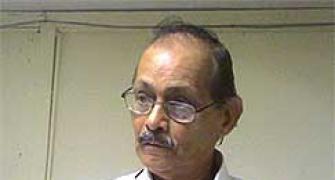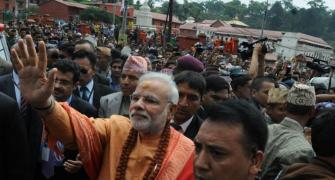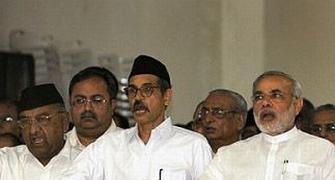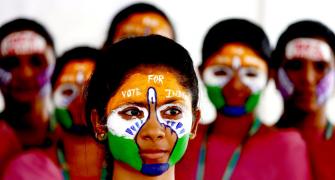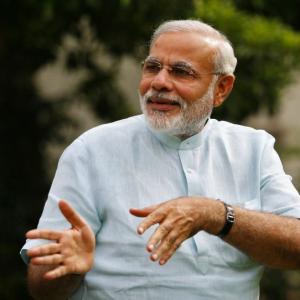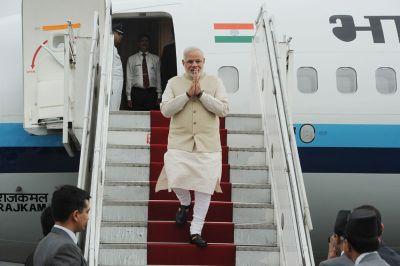 The advent of technology, the widespread use of smart phones across the country and the increasing popularity of the social media has caused the mushrooming of media platforms and led to the gradual disintermediation of the mainstream traditional media.
The advent of technology, the widespread use of smart phones across the country and the increasing popularity of the social media has caused the mushrooming of media platforms and led to the gradual disintermediation of the mainstream traditional media.
The BJP leadership has only caught on to this trend quite fast and has used it to counter the influence of the mainstream media, says A K Bhattacharya.
India's mainstream media is understandably upset over the manner in which the Narendra Modi government has chosen to engage with it. There is no doubt that the terms of engagement between the mainstream media (print and electronic) and the Modi government have changed quite significantly.
And since the media is acknowledged to be an important pillar in a democracy, such a change needs to be analysed and placed in perspective. No assessment of the Modi government will be complete without a proper understanding of this particular relationship and its implications for governance.
Lest this discussion is misunderstood, it should be noted at the outset that the perception of change in the terms of engagement between the media and the government has arisen not just from the recent decision by the prime minister not to carry large groups of senior representatives from the print and the electronic media as part of his delegation to the various foreign countries he is visiting.
Indeed, the manner in which previous prime ministers treated the convention of carrying journalists in the prime minister's plane had reduced the entire exercise to a pathetic practice of State-sponsored entertainment of some journalists at the expense of the taxpayer's money.
That such a practice has been done away with is to be welcome. Only a few news agency journalists now accompany the prime minister in his plane and this practice, too, should be phased out. After all, a free media should indeed remain unencumbered and uninfluenced by those whose actions and decisions it needs to scrutinise and comment on.
The problem, however, is that the reason for which such a practice should have been scrapped is not why such a decision seems to have been taken. An advantage of the media accompanying the prime minister in the latter's plane is that usually, at the conclusion of his visit, the prime minister holds a press briefing for journalists on board.
In an era when prime ministers rarely hold press conferences to address questions on a wide range of policies, the onboard press briefings become an opportunity for the media to subject the government's chief executive to scrutiny on policy issues. Now, with no media delegation on the prime minister's plane, the people of the country would come to know even less of what Modi's views are on public policies.
While media junkets must be scrapped, this cannot also become an instrument for the government to escape from public scrutiny and media questioning of its policies. Unfortunately, this is what appears to have prompted this decision, which in a way prevents the administration from succumbing to any media-generated pressure of public opinion in favour of desired policy changes or against some policy decisions already taken.
What this also means is that the media's power of intermediation or dissemination of public policy issues is considerably curtailed. You could argue that the disintermediation of the media is a reflection of the Modi government's realisation that its predecessor's growing unpopularity could be largely attributed to unhindered media scrutiny of its deeds and misdeeds. By not allowing the media such intermediation, the present government seems to have pre-empted possible sources of criticism or attack against it.
But the change in the terms of engagement or disintermediation of the media is evident not just in reducing the role of press briefings and conferences that could subject government representatives to media scrutiny. There are some other ways, too, this has been achieved.
Take, for instance, how most ministers are sharing with the media what initiatives they are taking. Gone are the days when ministers would use the trusted machinery of the Press Information Bureau, or the PIB, a division of the Union ministry of information and broadcasting. You still get the PIB press releases, backgrounders or discreet advisories on what is happening in which ministries. But they are no longer the preferred mode of communication for the Modi government. Social media tools, such as Facebook and Twitter, are being used extensively for government communication.
It will be naive to underestimate the crucial role of technology in the way the disintermediation of the mainstream traditional media has taken place in the Modi government. The use of social media tools for disseminating information among the media had begun a few years ago and many ministers in the United Progressive Alliance government were also using them. But the pace at which these tools have now supplanted the traditional mode of communication has been breathtaking.
Now why should this be a cause of concern for the mainstream media?
One, the central role the media played in influencing public opinion has been diluted as its access to information is much more restricted than before.
Two, the scope for public scrutiny of government functionaries, including ministers, so critical for an effective democracy, has been severely reduced and limited.
And, three, the social media tools have allowed only one-way communication from the government to the media, giving little scope for the media to scrutinise the government's statements through interviews, media briefings or press conferences.
In short, the mainstream media is feeling a little disempowered.
The reality that must dawn on the mainstream media is that it is no point blaming the Bharatiya Janata Party or the Modi government for its disintermediation in public policy dissemination.
It is the advent of technology, the widespread use of smart phones across the country and the increasing popularity of the social media that has caused the mushrooming growth of various types of media platforms and led to the gradual disintermediation of the mainstream traditional media. The BJP leadership has only caught on to this trend quite fast and has used it to counter the influence of the mainstream media.
The irony is that this transformation has been achieved with the help of patently foreign brands and externally funded companies -- and by a government that seems to swear by Swadeshi.
Image: Prime Minister lands at Kathmandu's Tribhuvan airport on April 2, 2014. Prime ministerial visits previously were accompanied by a fairly large media contingent, a practice that Modi has put a stop to.


